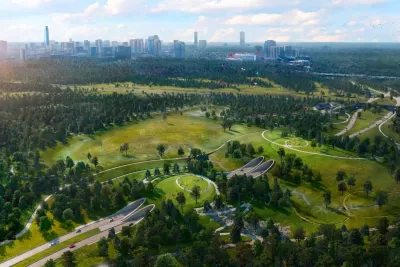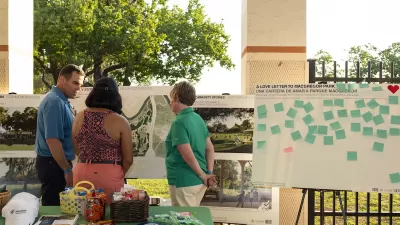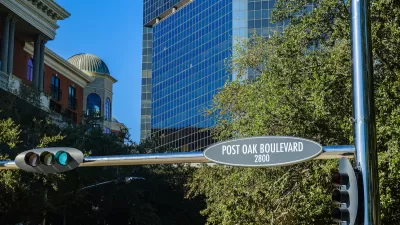The Houston Chronicle editorial board calls the newly redesigned park a “transformative” project, urging state transportation officials to take note.

The Houston Chronicle editorial board writes in praise of the transformative Memorial Park redesign, led by landscape architect Thomas Woltz of Nelson Byrd Woltz.
The 2015 master plan for the park, whose location has been the site of a series of important historical events, is the result of years of work that culminated in the relocation of a roadway and the construction of a $70 million land bridge. The design pays homage to the history of Camp Logan, a former World War I training facility where Black soldiers were killed after marching against abuse, though the board notes that “we'd like to see more signage to mark the history, and educate curious visitors about it.”
The editorial acknowledges the project’s critics, such as Susan Chadwick, leader of a group called Save Buffalo Bayou, who says the plan was a “vanity project” that altered the environment too much. The board disagrees, writing that, although they took issue with tax increment reinvestment zones (TIRZs) as a source of funding, “the transformation of Memorial Park is a remarkable public good.”
The board doesn't ignore the park's position as an ostensibly natural space in the middle of a vast metropolis.
“Woltz's team attempted to frame as picturesque a view as possible, but standing atop the land bridge tomorrow's picnic goers will still sense that they are in the middle of infrastructure — that big parks in Houston are also about building parking lots, that highways are also about flood management, that flood management is about parks and housing.”
Despite its limitations, the editorial board sees the Memorial Park project as a model for the Texas Department of Transportation (TxDOT), which has not factored green space or parks into its budget for rebuilding Interstate 45. “The Memorial Park master plan started off with wildlife connectivity, human connectivity, improved the human experience and public access.” In the opinion of the board, other major infrastructure projects should take the same approach.
FULL STORY: What Memorial Park can teach Texas' highway department (Editorial)

Alabama: Trump Terminates Settlements for Black Communities Harmed By Raw Sewage
Trump deemed the landmark civil rights agreement “illegal DEI and environmental justice policy.”

Planetizen Federal Action Tracker
A weekly monitor of how Trump’s orders and actions are impacting planners and planning in America.

The 120 Year Old Tiny Home Villages That Sheltered San Francisco’s Earthquake Refugees
More than a century ago, San Francisco mobilized to house thousands of residents displaced by the 1906 earthquake. Could their strategy offer a model for the present?

Opinion: California’s SB 79 Would Improve Housing Affordability and Transit Access
A proposed bill would legalize transit-oriented development statewide.

Record Temperatures Prompt Push for Environmental Justice Bills
Nevada legislators are proposing laws that would mandate heat mitigation measures to protect residents from the impacts of extreme heat.

Downtown Pittsburgh Set to Gain 1,300 New Housing Units
Pittsburgh’s office buildings, many of which date back to the early 20th century, are prime candidates for conversion to housing.
Urban Design for Planners 1: Software Tools
This six-course series explores essential urban design concepts using open source software and equips planners with the tools they need to participate fully in the urban design process.
Planning for Universal Design
Learn the tools for implementing Universal Design in planning regulations.
Clanton & Associates, Inc.
Jessamine County Fiscal Court
Institute for Housing and Urban Development Studies (IHS)
City of Grandview
Harvard GSD Executive Education
Toledo-Lucas County Plan Commissions
Salt Lake City
NYU Wagner Graduate School of Public Service





























